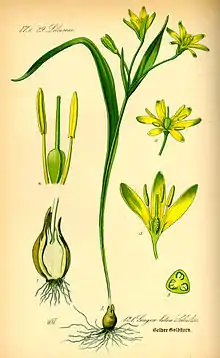| Gagea lutea | |
|---|---|
 | |
| 1885 illustration[1] | |
| Scientific classification | |
| Kingdom: | Plantae |
| Clade: | Tracheophytes |
| Clade: | Angiosperms |
| Clade: | Monocots |
| Order: | Liliales |
| Family: | Liliaceae |
| Subfamily: | Lilioideae |
| Tribe: | Lilieae |
| Genus: | Gagea |
| Species: | G. lutea |
| Binomial name | |
| Gagea lutea (L.) Ker Gawl | |
| Synonyms[2] | |
|
Synonymy
| |
Gagea lutea, known as the Yellow star-of-Bethlehem, is a Eurasian flowering plant species in the family Liliaceae. It is widespread in central Europe with scattered populations in Great Britain, Spain, and Norway to Siberia and Japan.[3][2]
G. lutea is a bulb-forming herbaceous perennial with lanceolate leaves and green-tinged yellow flowers with 6 tepals.[4][5][6] It is a predominantly lowland species that inhabits moist, base-rich, shady habitats including; broad-leaf woodlands, hedgerows, limestone pavements, pastures, and riverbanks.[7] It has been used as an indicator of ancient woodland in East Anglia.[8]
References
- ↑ illustration from Prof. Dr. Otto Wilhelm Thomé Flora von Deutschland, Österreich und der Schweiz 1885, Gera, Germany
- 1 2 "Kew World Checklist of Selected Plant Families, Gagea lutea". Retrieved 1 February 2019.
- ↑ "Gagea (L.) Ker Gawl". Plants of the World Online. Royal Botanic Gardens, Kew. Retrieved 19 March 2023.
- ↑ John Bellenden (1809). "Gagea lutea, yellow gagea". Curtis's Botanical Magazine. 30: 1200. Retrieved 1 February 2019.
- ↑ "The Plant List: Ornithogalum luteum". Royal Botanic Gardens Kew and Missouri Botanic Garden. Retrieved 1 February 2019.
- ↑ Altervista Flora Italiana, Cipollaccio giallo stellato Gagea lutea (L.) Ker Gawl.
- ↑ P.A. Stroh, T. A. Humphrey, R.J. Burkmar, O.L. Pescott, D.B. Roy, & K.J. Walker (ed.). "Gagea lutea (L.) Ker Gawl". BSBI Online Plant Atlas 2020. Botanical Society of Britain and Ireland. Retrieved 19 March 2023.
{{cite web}}: CS1 maint: multiple names: editors list (link) - ↑ Francis Rose (1999). "Indicators of ancient woodland" (PDF). British Wildlife: 246. Retrieved 7 April 2020.
External links
This article is issued from Wikipedia. The text is licensed under Creative Commons - Attribution - Sharealike. Additional terms may apply for the media files.